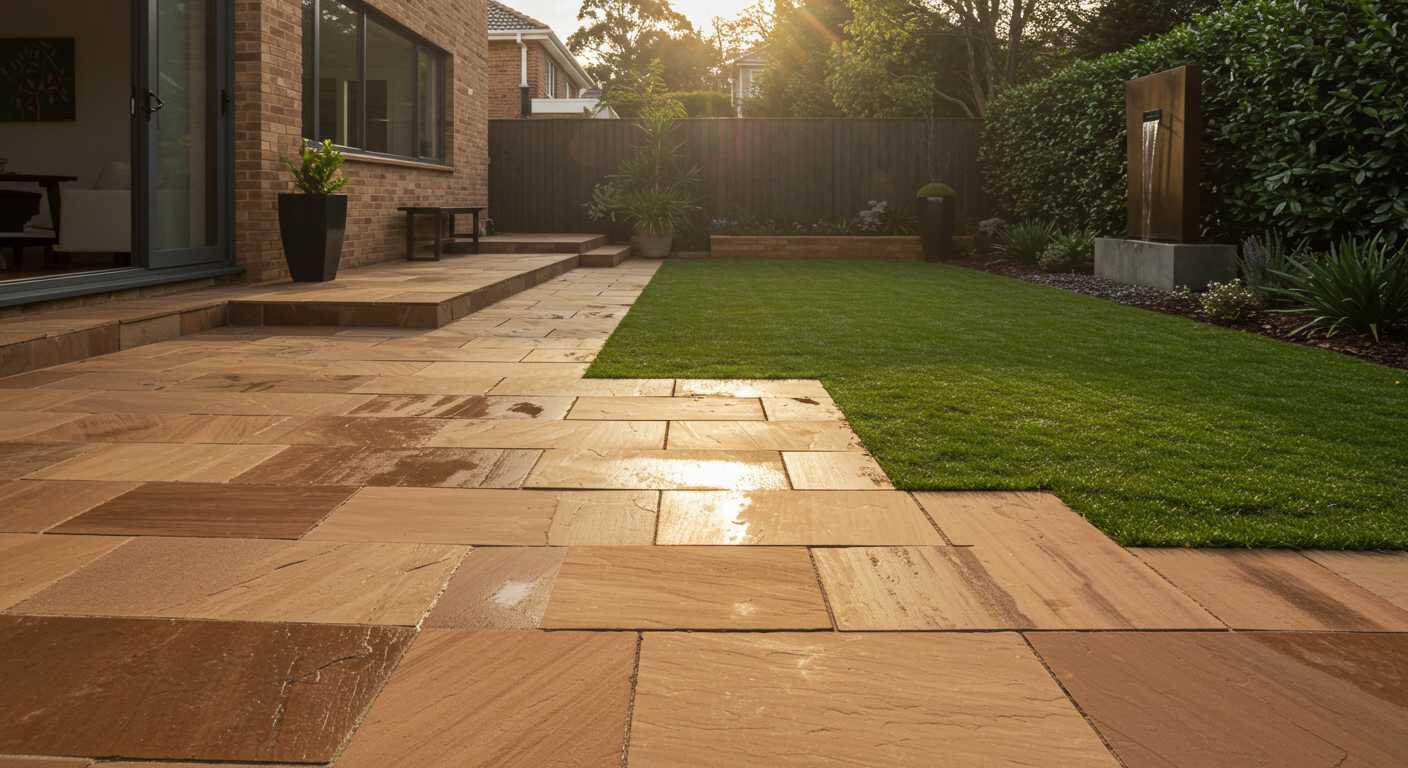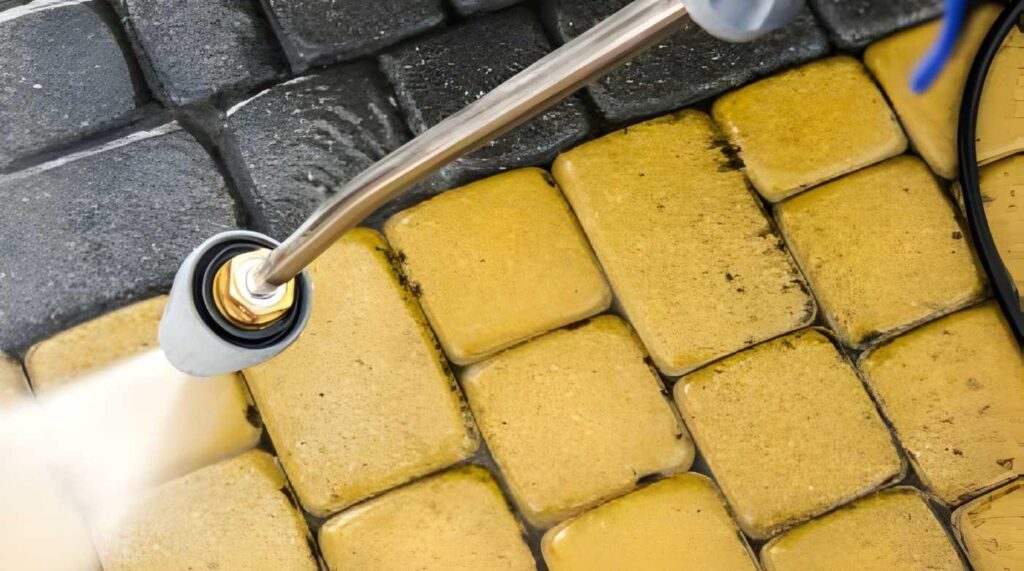That gritty film building up on your sandstone pavers isn’t just dirt – it’s the slow fade of your outdoor charm. It’s frustrating seeing the entrance you once loved now look tired, stained, and patchy, especially when guests notice it before you do.
Sandstone gives any space a classic, natural look, but its porous surface traps grime, algae, and unwelcome streaks. If you’ve been wondering how to clean sandstone pavers without damaging them, the key is selecting the right tools and employing gentle cleaning methods. Scrubbing with harsh chemicals or the wrong brushes makes things worse, leaving marks or spreading stains instead of removing them.
At Refined Exterior Cleaning, we help Melbourne property owners like you keep sandstone surfaces fresh, clean, and looking their best for years to come.
Our expert team knows the safe methods and right gear that gently lift years of wear without harming your stonework.
Understanding Sandstone Pavers
Understanding sandstone pavers is the first step in learning how to clean them effectively, as knowing their texture, finish, and vulnerabilities helps you choose the safest cleaning method.
Characteristics of sandstone surfaces
Each sandstone paver has a unique blend of earthy tones and textures that adds a classic feel outdoors. However, its porous surface absorbs water and grime easily, which means regular upkeep is necessary to keep it looking good.
Common uses in Australian outdoor designs
In Melbourne gardens or patios, sandstone is often used for pool surrounds, pathways, and alfresco areas. Its natural look blends well with outdoor themes while remaining versatile for both rustic and modern layouts.
Vulnerability to weather and staining
Melbourne’s rain and sun can weather sandstone quickly, leading to blotches, dark patches, or green growth. Unsealed stone absorbs spills quickly, and without proper protection, mould and moss can settle deeply into its layers.
Types of sandstone and their finishes
Options like Himalayan, Indian, and Sydney sandstone are available with finishes such as honed, sawn, or split-faced textures. Each finish feels and behaves differently under weather exposure, so cleaning techniques should match the surface type.
Essential Preparation Before Cleaning
Before diving into the step-by-step process of cleaning sandstone pavers, it’s essential to prepare your surface and gather the necessary tools. This prevents accidental damage and ensures a more even, professional finish.
Checking if the pavers are sealed or unsealed
Run a water drop test-if water beads, the paver’s sealed; if it darkens quickly, it’s unsealed.
Knowing this helps you avoid using harsh cleaners that might soak in and stain deeper layers of unsealed surfaces.
Gathering appropriate tools and materials
You’ll need a soft brush, garden hose, protective gloves, mild detergent, and a bucket or low-pressure cleaning sprayer.
Avoid anything metal or wire-based, as it can scrape and permanently mark soft sandstone.
Preparing the surrounding area and testing a small patch
Clear leaf litter, furniture, and any nearby décor to avoid splashes or runoff damage.
Always scrub a small hidden section first to see if your technique causes any colour shifts or surface harm.
Safety precautions before beginning
Wear gloves, non-slip shoes, and keep pets or kids away from your work zone.
Avoid mixing chemicals or skipping instructions, as some surfaces react badly to standard cleaners.
General Cleaning Methods
Once you’ve prepped the area, it’s time to focus on how to clean sandstone pavers the right way, using gentle, consistent methods that protect their colour and texture over time.
Light cleaning with water and soft brushes
Rinsing sandstone weekly with water and a soft-bristled broom prevents mildew and dust buildup. This gentle scrub freshens the look without wearing down the surface, unlike harsh brushing.
Using eco-friendly or homemade cleaning solutions
A mix of warm water and mild dish soap or white vinegar suits most sandstone surfaces well.
We recommend spot-testing natural options first to check for any unexpected colour change.
Avoiding abrasive or acidic products
Steer clear of acidic cleaners or bleach, as these can break down the minerals in the stone too aggressively. Instead, focus on non-toxic, pH-balanced solutions specifically designed for use on natural stone.
Frequency of periodic maintenance
A general clean every month maintains the paver’s colour and integrity. Deep cleaning every six months helps prevent long-term damage and heavy discolouration.

Targeted Stain Removal Techniques
Even with regular upkeep, stubborn marks can still appear. Learning how to clean sandstone pavers using targeted stain removal techniques can help restore their original look without causing damage to the stone.
Dealing with organic stains like leaves or food
Leaf stains or rotting fruit marks can be removed with a baking soda paste left to sit and gently brushed off later. Use warm water rinses immediately after food spills to prevent sticky patches or dark rings.
Remove grease stains from the sandstone patio
Sprinkle kitty litter or cornflour to absorb fresh grease, then scrub with warm soapy water.
Avoid scrubbing too hard; let the solution do the work and rinse thoroughly.
Paint, rust, or oil treatment methods
Rust or paint marks may need a poultice of hydrogen peroxide and baking soda.
Oil marks, if soaked in deeply, should be treated with an enzymatic degreaser made explicitly for stone.
Acid wash for removing stains from sandstone pavers
This is a last-resort option that should be handled by professionals, such as our team at Refined Exterior Cleaning. We use controlled methods to neutralise surfaces immediately after washing to prevent erosion.
Frequently Asked Questions
What is the best cleaner for sandstone?
A neutral pH cleaner or mild dish soap mixed with warm water works best.
Avoid acid-based or heavy degreasers.
How to Remove Black Stains or Mould from Sandstone?
Apply a mould remover made for stone and let it sit for 15 minutes. Scrub lightly with a soft-bristle brush and rinse well.
Is vinegar safe for cleaning sandstone?
No, vinegar is acidic and can etch the surface. Stick with pH-neutral options for safe cleaning.
Can chlorine be used on sandstone surfaces?
Chlorine can discolour and corrode sandstone. Our eco-friendly cleaners deliver better results without damaging the pavers.
What is the best time of year to clean sandstone paving?
Spring and early summer are ideal, as surfaces dry faster and there’s less chance of sealing in moisture. Avoid rainy seasons or winter for deep cleans and sealing.


